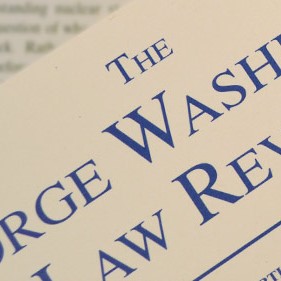Kristin E. Hickman · August 2008
76 GEO. WASH. L. REV. 1153 (2008)
The Treasury Department (“Treasury”) promulgates hundreds of regulations interpreting the Internal Revenue Code (“I.R.C.”). In a recent article, I outlined and documented empirically why, under general principles of administrative law, a substantial percentage of Treasury regulations interpreting the I.R.C.—more than forty percent of those studied—are susceptible to legal challenge for Treasury’s failure to follow procedural requirements imposed by the Administrative Procedure Act (“APA”). I also suggested that the failings I identified may not be the only procedural problems with Treasury’s rulemaking efforts. Tremendous potential exists for unhappy taxpayers to challenge Treasury regulations in court for their procedural failings.
Yet, despite plenty of tax litigation, including frequent claims that Treasury regulations are substantively flawed, taxpayers rarely contest Treasury regulations on procedural grounds. Given Treasury’s track record, one is left with the question: why do we not see more such claims?
It may well be that many taxpayers are satisfied with any guidance that allows them to arrange their affairs with certainty. But the idea that all taxpayers are so satisfied with Treasury’s regulatory efforts as to render procedural challenges unthinkable is simply untenable. Many Treasury regulations are controversial and impose significant tax or reporting burdens on taxpayers. Even those regulations that please many or even most taxpayers nevertheless draw lines that either include taxpayers who think they should be excluded or vice versa. Further, many regulations address questions with sizeable financial consequences that far outstrip the potential costs of litigation and thus arguably justify allocating the resources to challenge rather than acquiesce to the regulation.
Maybe tax lawyers are simply unaware of the procedural arguments available. Some degree of tax community ignorance of nontax administrative law principles undoubtedly contributes to the paucity of procedural challenges. Many years ago, government officials responsible for drafting Treasury regulations were also well versed in the requirements of administrative law. Over time, however, benign neglect and a restructuring of Internal Revenue Service (“IRS”) personnel and priorities have yielded contemporary drafters of tax regulations with little knowledge of or regard for administrative law requirements. Correspondingly, other tax scholars have observed the tax bar’s insular nature and resulting tendency to disregard potentially relevant nontax legal doctrine.
From these trends, one might conclude that many taxpayers and tax lawyers simply accept at face value Treasury’s representation that most of its regulations are exempt from APA rulemaking requirements. For others who might be more skeptical of Treasury’s exemption claims, the relevant administrative law jurisprudence may be far enough outside their experiential comfort zone to cause them to shy away from raising claims based on administrative law. While any of these possibilities may be true in some cases, they are ultimately unsatisfying as the whole story. Trade and taxpayer groups pay close attention to relevant tax law changes. The tax bar and its clients are, collectively, highly sophisticated. The significant dollars at stake in many high-profile tax cases make it unlikely that the possibility of challenging unfavorable Treasury regulations on procedural grounds lies wholly undetected.
Another possible explanation, the subject of this Article, is that statutory and doctrinal limitations combine in the tax context to deter taxpayers from pursuing APA compliance claims. Part I of this Article offers a brief summary of Treasury’s procedural failings. Part II.A of this Article then looks at statutory prohibitions against injunctions and declaratory judgments in the tax context that the courts have applied to preclude virtually all pre-enforcement judicial review of tax matters. Though the jurisprudence is surprisingly underdeveloped, Part II.B examines how broader justiciability limitations such as standing and ripeness may present an additional burden upon taxpayers seeking pre-enforcement review. Part III considers further limitations imposed by “enforcement-based” judicial review of tax cases—that is, review of cases commenced after the IRS applies the tax laws to individual taxpayers. Specifically, Part III.A summarizes the administrative burdens imposed upon those seeking judicial review through tax refund or deficiency actions. Part III.B reflects upon the potential futility of challenging temporary regulations in such cases. Part III.C examines the possible impact and resulting deterrent effect of judicial deference doctrines that govern courts’ consideration of enforcement-based, as-applied tax challenges.

